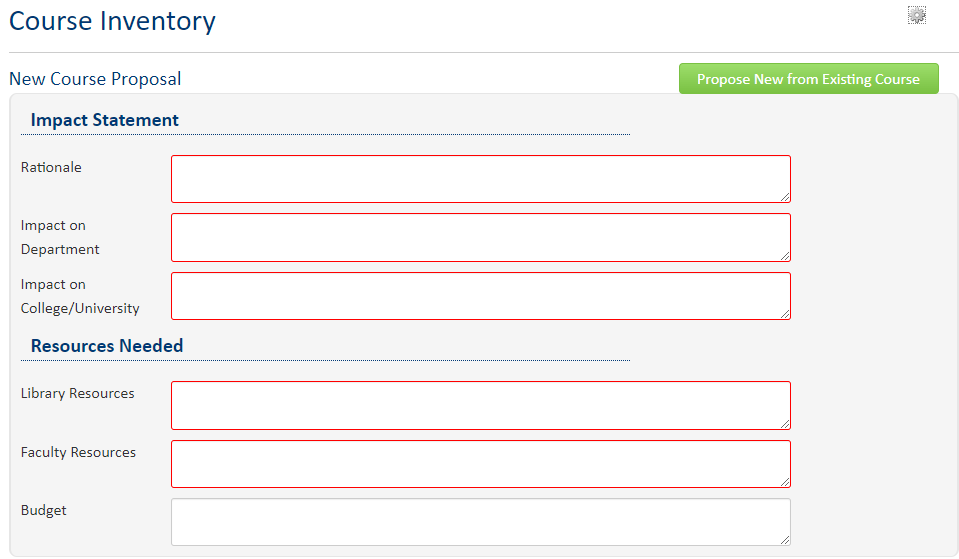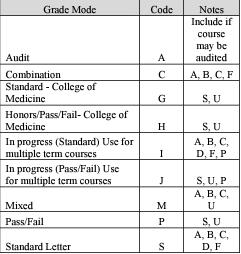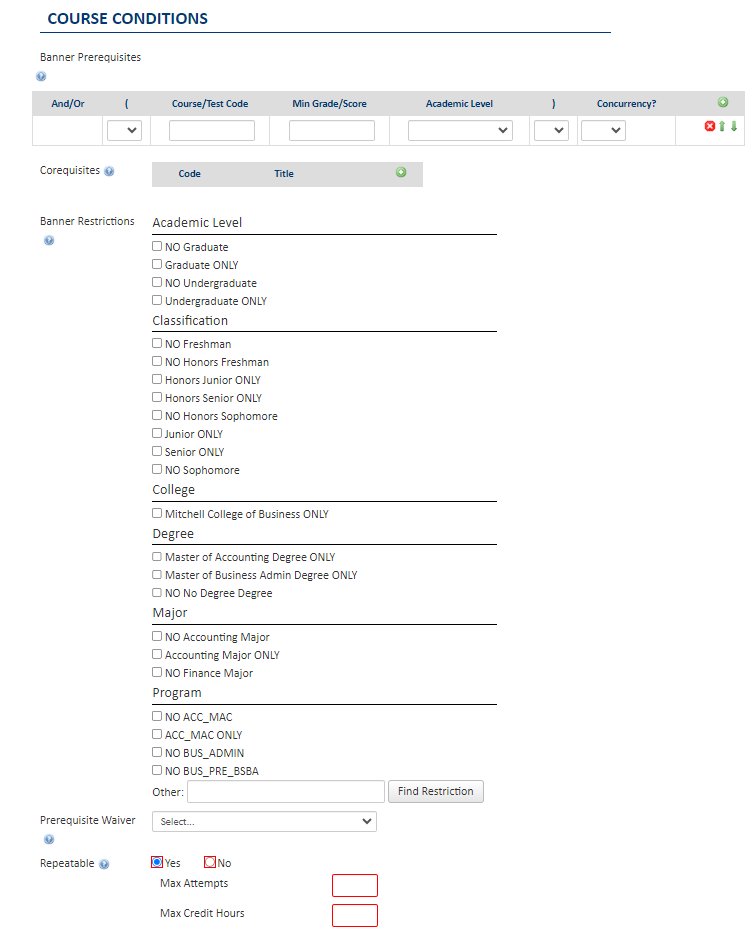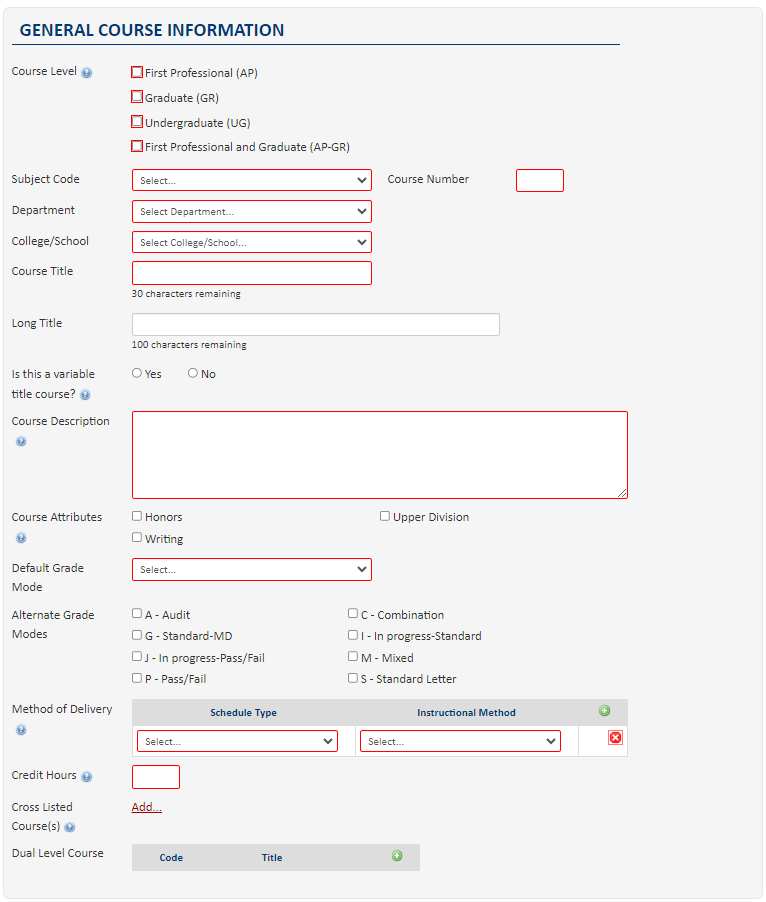Proposing a New Course
Proposed new courses should be timed to begin with a new academic year and are only eligible to appear in the Bulletin if they are submitted prior to the deadline.
From the Course Inventory Management page select “Propose New Course”. This will take you to the New Course Proposal screen with several sections. Items in red outline are required. Items with a blue question-mark icon have additional instructions at the icon.
The action buttons at the bottom of the screen will allow you to save or submit proposals.
![]()
Cancel will close the window and not save anything you have entered on the form.
Save Changes will allow you to save your work and come back to the form at a later time to make further edits and/or submit. You can save without filling out all of the required fields.
Start Workflow will save your work and submit your proposal into the approval workflow. All required fields must be completed before workflow can be started. If any required fields are incomplete, you will see a pop-up error message with the missing fields indicated. Once your proposal has been submitted to workflow, the list of workflow steps will appear on the right side of the screen in the workflow field. As workflow steps are completed, they will appear in the "Approval Path" box below the workflow steps.

On the upper-right of the New Course Proposal screen, you have the option to Propose New from Existing Course. Choosing this option will allow you to select an existing course to pre-populate sections of the New Course Proposal page. Note however that if you select this option, you must still carefully review each pre-populated field to make sure it is appropriate for the proposed course.
Some course types follow a standard numbering convention. For example, Special Topics courses end in “90”; they are 490, 390, 290. Directed Studies end in “94”, they are 494, 394, 294, and Thesis courses end in “99”.
If you plan to cross-list the course, use the same number as the cross-listed course. If both courses to be cross-listed are new, submit one proposal for each.
If the proposed course is to be dual-level, select a number that will share the last two digits with the other level course (e.g., 472 and 572). Submit one proposal for each course.
Selecting the subject code will also fill in the appropriate College and School fields.
Limited to 30 characters for entry into Banner
100 characters maximum
Variable Title Courses such as special topics have all or part of their title entered on the section level each term. Variable Title Courses still require the creation of a course shell on the catalog level. Although the title will vary, the proposal should still include a sample syllabus showing how the course would be taught and a credit hour estimate form.
Include a description to be used in the bulletin and on the course syllabus. Unless a variable title course, this description must match the description on the syllabus.
Honors courses must be approved by the Honors College. Writing Courses must be approved by the University Writing Committee. Selecting “Honors” or “Writing” will route the proposal to the appropriate committee in the Workflow.
Select the appropriate grade mode. Remember that graduate (GR) level courses cannot include “D” letter grades and are typically Combination (“C”) grade mode.

Select the Schedule Type and Instructional Method for the proposal. The Schedule Type should match the Instructional Method, e.g., Web-based (W) should have an online instructional method such as “WO”.
You can add more than one method of delivery to your proposal by clicking the green plus on the upper right, but the one listed first will be the default:

Note that for each schedule type a syllabus and Credit Hour Estimate form appropriate to that type must be uploaded with your proposal.
The syllabus for the course should follow the Policy on Course Formats for the instructional method chosen.
Enter the credit hours, including a range for variable hours courses.
If proposing a cross-listed course, enter the proposed cross-listing here. If both courses are new, they will each require a separate proposal and be cross-listed with each other. Cross-listed courses should have the same course number but differ in prefix (e.g., HY 465 and REL 465). They typically have the same title.
Dual-level courses, which are courses taught at both graduate and undergraduate levels, typically have the same prefix and share the last two digits (e.g., HY 457 and HY 557).
Click the green plus icon to select a course to list as dual-level with the proposed course.

Begin adding any course conditions using the plus button at the upper right to add additional fields and the up and down arrows to move conditions up or down. Conditions are set by Boolean operators: and, or, and parentheses. Enter any tests and minimum scores, and prerequisite courses with minimum grades required to qualify as a prerequisite.

Enter a 'Y' if the prerequisite course may be taken in the same term as this course. Indicate if the course requires Professional Component standing or Undergraduate Candidacy (College of Education).
Use this area to indicate whether a course is restricted to or from a specific college, class, major, or level. Use 'I' for 'Include' and 'E' for 'Exclude' to identify the specific population of students affected (e.g. "Include - Graduates")
Indicate who can waive a pre-requisite. Indicate only one.
Indicate if the course is repeatable. Note that a repeatable course is not automatically repeatable for credit; to allow a course to be repeatable for credit, select “Yes” and then select a Max Attempts greater than two and a Max Credit Hours value at least two times the course credit hours (if fixed) or two times the maximum credit hours of the course (if variable). If no attempt limit is indicated, the University repeat policy will apply.
Note that if a course is not repeatable, undergraduate students will not be able to attempt the course again for a grade replacement.
Upload the Credit Hour Estimate for the proposal. If more than one schedule type was selected, upload one Credit Hour Estimate form for each schedule type. Each Credit Hour Estimate form must be completed in a way appropriate for the instructional methods of the course. Consult the University Policy on Course Formats for details.
If a course is variable credit hours (e.g., 1-3), complete the Credit Hour Estimate form using the minimum hours the course could be offered (e.g., 1).
Upload a complete example of the course syllabus. The course syllabus must follow the course syllabus template.
If more than one schedule type was selected, upload one syllabus for each schedule type. Each syllabus must be constructed in a way appropriate for the specific instructional methods of the course. Consult the University Policy on Course Formats for details.
Remember to include the following on the syllabus:
- all items indicated in red on the syllabus template;
- Student Learning Outcomes. Student Learning Outcomes should include an indication of what a student should be able to do upon completion of the course;
- penalties for academic misconduct or late work, if any;
- record of attendance needed to assign an F* grade;
- any additional student charges associated with establishing student identification or exam proctoring.
Attachments may include memos from the proposer explaining the purpose of the proposal (e.g., if a proposed course is a re-numbering of an existing course), documents supporting student demand or other factors discussed in the Rationale section, or letters of support from appropriate stakeholders for the proposal.



